Indus Valley Civilization Architecture
Harappan Settlements:
- The fact that the Harappan civilization was urban does not mean that all or even most of its settlements had an urban character. A majority were in fact villages.
- The Harappan sites varied a great deal in size and function, from large cities to small pastoral camps.
- The largest settlements include Mohenjodaro, Harappa, Ganweriwala, Rakhigarhi, and Dholavira.
- The second rung of Harappan settlements are moderate-sized sites ranging between 10 and 50 ha, such as Kalibangan.
- Then, there are the even smaller sites of 5–10 ha, such as Amri, Lothal, Chanhudaro, and Rojdi.
- The many settlements less than 5 ha include Allahdino, Kot Diji, Rupar, Balakot, Surkotada, Nausharo, and Ghazi Shah.
Town-Planning:
- Unity of conception:
- Archaeologists like Mortimer Wheeler and Stuart Piggot believed that the Harappan towns had a remarkable unity of conception. This was suggested by the division of each town into two parts.
- In one part was a raised citadel where the rulers were staying;
- In the other part of the town lived the ruled and the poor.
- This unity of planning would also mean that -the houses, the granaries, the streets and many other structures of Harappa will be almost identical to those of Mohenjodaro or any other Harappan town.
- The entire idea of unity of conception was derived from the notion of a community of foreigners suddenly conquering the Indus Valley and building new towns.
- Such towns were designed to separate the natives from the rulers.
- Thus, the rulers built citadels which kept them in glorious isolation.
- Such ideas of the sudden emergence of the Harappan towns and the unity of planning are being increasingly rejected by new scholars.
- Archaeologists like Mortimer Wheeler and Stuart Piggot believed that the Harappan towns had a remarkable unity of conception. This was suggested by the division of each town into two parts.
- The Harappan towns were located on the flood-plains of rivers, on fringes of deserts or on sea coast.
- This meant that people living in these different regions faced different kinds of challenges from nature.
- Their adaptation to environment would introduce diversity in their town-planning and life style.
- Also many large and seemingly important buildings were located in the lower city.
- The details of the plans differ.
- Mohenjodaro, Harappa, and Kalibangan have a similar layout, consisting of a raised citadel complex and a lower city.
- At Lothal and Surkotada, the citadel complex is not separate; it is located within the main settlement.
- In its most fully developed phase, Dholavira consisted of not two but three parts—the citadel, middle town, and lower town.
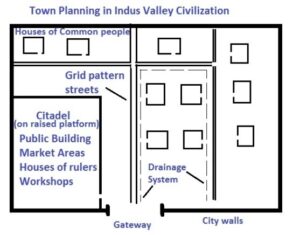
- Citadel and lower town:
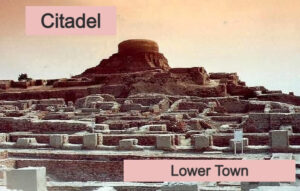
-
- The settlements of Harappa, Mohenjodaro and Kalibangan show certain uniformity in their planning.
- These cities were divided into a upper town called the citadel on the west side and a lower town on the eastern side of the settlement.
- Citadel was built on a high podium of mud brick.
- The citadel seems to have contained large structures which might have functioned as administrative or ritual centres.
- The citadel at Harappa measuring 1400 ft. x 600 ft. on mound 40 ft. high which faced foundation with brick embankment 45 ft. thick.
- The citadel at Mahenjo-daro included a very large building that may have been a palace.
- Lower Town was the residential area where the common people lived.
- Citadel was built on a high podium of mud brick.
- City wall:
- City in the Indus Valley was surrounded by massive walls and gateways.
- The walls may have been built to control trade, military invasion and also to stop the city from being flooded.
- Each part of the city was made up of walled sections. Each section included different buildings such as: Public buildings, houses, markets, craft workshops, etc.
- In Mohenjodaro and Harappa the citadel was surrounded by a brick wall.
- Although the citadels were walled, it is far from clear that these structures were defensive. They may have been built to divert flood water.
- At Kalibangan both the citadel and the lower city were surrounded by a wall.
- In settlements like Kot Diji and Amri in Sind there was no fortification of the city.
- The site of Lothal in Gujarat also shows a very different layout.
- It was a rectangular settlement surrounded by a brick wall.
- It did not have any internal division into citadel and lower city.
- Along the eastern side of the town was found a brick basin which has been identified as a dockyard by its excavator.
- The site of Surkotada in Cutch was divided into two equal parts and the building materials were basically mud bricks and lumps of mud.
- Street:
- The streets and houses of Harappan cities are thought to be laid on a grid-pattern oriented north–south and east–west.
- But even Mohenjodaro does not show a perfect grid system.
- Roads in the Harappan cities were not always absolutely straight and did not always cross one another at right angles.
- But the settlements were clearly planned.
- There is no strict correlation between the level of planning and the size of a settlement.
- For example, the relatively small site of Lothal shows a much higher level of planning than Kalibangan, which is twice its size.
- There were covered drains along the road. Houses were built on either side of the roads and streets.
- Each street had a well organized drain system. If the drains were not cleaned, the water ran into the houses and silt built up. Then the Harappans would build another storey on top of it. This raised the level of the city over the years.
- Obviously, this kind of alignment of streets and houses represents conscious town planning. However, the resources of the town planners in those days would be very limited.
- This assumption is based on the finds from Mohenjodaro and Kalibangan where the streets stagger from block to block and the alignments of streets and buildings in one part of Mohenjodaro is quite different from the rest of the areas.
- Mohenjodaro was not constructed in homogeneous horizontal units. In fact it was built in different times.
- The streets and houses of Harappan cities are thought to be laid on a grid-pattern oriented north–south and east–west.
- Granaries:
- The granary was the largest structure in Mohenjodaro, in Harappa there were about six granaries or storehouses. These were used for storing grain.
- Large granaries suggest that the state stored grain for ceremonial purposes and possibly the regulation of grain production and sale.
- Granary of Mohenjodaro:
- It was discovered in the citadel mound of Mohenjodaro is the granary.
- It consists of twenty seven blocks of brickwork crisscrossed by ventilation channels.
- Below the granary were the brick loading bays from which grains were raised into the citadel for storage.
- Though some scholars have questioned the identification of this structure with a granary but it is certain that this large structure must have had some important function.
- Great Granary of Harappa:
- It consisted of a series of brick platforms forming the base of two rows of six granaries.
- To the south of the granary were found rows of circular brick platforms.
- That they were used for threshing grains is clear from the fact that chaffs of wheat and barley were found in the crevices of the floors.
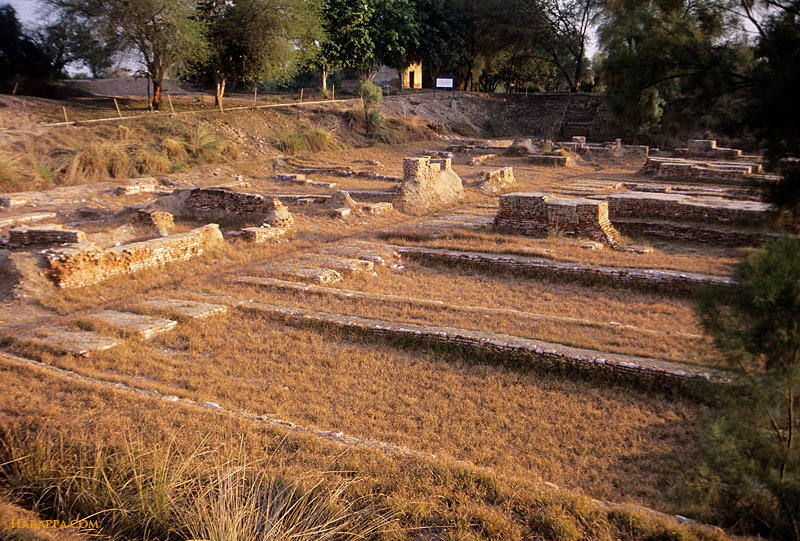
- Some other structures:
- In Harappa, Mohenjodaro and Kalibangan, the citadel areas contained monumental structures which must have had special functions. This is clear from the fact that they stood on a high mud brick platform.
- To another side of the Great Bath is a long building (230 x 78 feet) which has been identified as the residence of a very high official.
- It includes an open court of 33 feet square on to which three verandas open.
- Another significant building was an assembly hall.
- It had four rows of five brick plinths upon which wooden columns were erected.
- In a row of rooms to the west of it was found a seated male statue.
- Kalibangan was a smaller city compared to Mohenjodaro and Harappa.
- The most significant discoveries here have been those of fire altars. A series of brick platforms were discovered. On one of them was found a row of seven ‘fire altars‘ as well as a pit containing animal bones and antlers.
Housing Pattern:
- People lived in houses of different sizes, mostly consisting of rooms arranged around a central courtyard.
- The average citizen seems to have lived in the blocks of houses in the lower city.
- Here too there were variations in the sizes of houses.
- It could be single room tenements meant for slaves like the ones discovered near the granary in Harappa.
- There were other houses complete with courtyards and moving upto twelve rooms.
- In the larger houses, passages led into inner rooms, and there is evidence of frequent renovation activity.
- Bigger houses had much the same plan- a square courtyard around which were a number of rooms.
- The bigger houses or groups of houses were provided with separate private wells, bathing areas and toilets.
- Bathing platforms with drains were often located in rooms next to a well.
- The floor of the bathing area was usually made of tightly fitted bricks, frequently set on edge, to make a carefully sloped watertight surface.
- A small drain led from here, cut through the house wall, and went out into the street, connecting ultimately with a larger sewage drain.
- Small houses attached to large ones may have been the quarters of service groups working for wealthy city dwellers.
- Doorways and windows generally faced the side lanes and rarely opened onto the main streets.
- The entrances to the houses were from the narrow lanes which cut the streets at right angles.
- The view from the lane into the courtyard was blocked off by a wall.
- Kitchen:
- Generally house had an indoor and outdoor kitchen.
- The outdoor kitchen would be used when it was warmer (so that the oven wouldn’t heat up the house), and the indoor kitchen for use when it was colder.
- In present day, village houses in this region (e.g. in Kachchh) still have two kitchens.
- Staircases:
- There are remains of staircases that may have led to the roof or a second storey.
- The fact that some of the houses at Mohenjodaro were two stories high or more is also suggested by the thickness of their walls.
- Floors:
- Floors were usually made of hard-packed earth, often re-plastered or covered with sand.
- Ceilings:
- The ceilings were probably over 3 m high.
- Roofs may have been made of wooden beams covered with reeds and packed clay.
- Doors and windows:
- The doors and windows of houses were made of wood and mats.
- Clay models of houses show that doors were sometimes carved or painted with simple designs.
- Windows had shutters (perhaps made of wood or reeds and matting), with latticework grills above and below to allow in light and air.
- A few pieces of carved alabaster and marble latticework have been found at Harappa and Mohenjodaro; such slabs may have been set into the brickwork.
- Toilets:
- Although some people may have used the area outside the city walls to relieve themselves, toilets have been identified at many sites.
- They ranged from the simple hole in the ground above a cesspit to more elaborate arrangements.
- Recent excavations at Harappa have uncovered toilets in almost every house.
- The commodes were made of big pots sunk into the floor, many of them associated with a small lota-type jar, no doubt for washing up.
- Most of the pots had a small hole in the base, through which water could seep into the ground.
- The waste from the toilets was in some cases discharged though a sloping channel into a jar or drain in the street outside.
- Some people must have had the job of cleaning the toilets and drains on a regular basis.
- Although some people may have used the area outside the city walls to relieve themselves, toilets have been identified at many sites.
- The house-building in some villages in the region still resembles in some respects the house-building of the Harappans.
Raw material used:
- A major difference between the buildings in large cities and those in smaller towns and villages was in the type and combination of raw materials used.
- In villages, houses were made mostly of mud-brick, with the additional use of mud and reeds; stone was occasionally used for foundations or drains.
- Buildings in towns and cities were made of sun-dried and burnt bricks.
- In Harappa and Mohenjodaro baked bricks were used for buildings. In Kalibangan mud bricks were used.
- In the rocky areas of Kutch and Saurashtra, however, there was extensive use of stone.
- The massive fortification walls with a veneer of dressed stone at Dholavira and the remains of stone pillars in the citadel are very distinctive and are not found at any other Harappan site.
- The fact that some house walls at Mohenjodaro survive upto a height of 5 m is a tribute to the strength of the bricks and the brick-laying skill of the Harappans.
- There were various styles of laying bricks, including what is known as the ‘English bond style’.
- In this, bricks were laid together in a sequence of long side (stretcher) and short side (header), with an alternate arrangement in consecutive rows. This gave the wall maximum load-bearing strength.
-
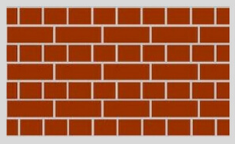
English bond of brick laying
-
- In this, bricks were laid together in a sequence of long side (stretcher) and short side (header), with an alternate arrangement in consecutive rows. This gave the wall maximum load-bearing strength.
- A striking feature of Harappan structures is the uniformity in the average size of the bricks—7 × 14 × 28 cm for houses and 10 × 20 × 40 cm for city walls.
- Both these brick sizes have an identical ratio of thickness, width, and length (1:2:4).
- This ratio first makes its appearance at a few sites in the early Harappan phase, but in the mature Harappan phase, it is found in all the settlements.
- Bricks of standard size shows that it was not the individual house owners who made their own bricks, but that brick making was organised on a large scale.
Water Management System:
- Drainage System:
- An efficient and well-planned drainage system is a notable feature of Harappan settlements.
- Even the smaller towns and villages had impressive drainage systems.
- The drains for collecting rainwater were separate from the sewage chutes and pipes.
- Drains and water chutes from the second storey were often built inside the wall, with an exit opening just above the street drain.
- At Harappa and Mohenjodaro, terracotta drain pipes directed waste water into open street drains made of baked bricks.
- These connected into large drains along the main streets, which emptied their contents into the fields outside the city wall.
- The main drains were covered by corbelled arches made of brick or stone slabs.
- There were rectangular soakpits for collecting solid waste at regular intervals.
- These must have been cleaned out regularly, otherwise the drainage system would have become choked and a health hazard.
-

washroom drainage system at Lothal. - Excellent arrangements for sanitation indicates the presence of a civic administration which would take decisions for the sanitary requirements of all the townsmen.
- Bathing and drinking:
- The Harappans made elaborate arrangements for water for drinking and bathing.
-
- The emphasis on providing water for bathing, evident at several sites, suggests that they were very particular about personal hygiene.
-
- It is possible that frequent bathing also had a religious or ritualistic aspect. The sources of water were rivers, wells, and reservoirs or cisterns.
- The Great bath at Mohenjodaro is a unique example.
- This brick built structure measures 12 m. x 7 m. and is about 3 m. deep.
- It is approached at either end by flights of steps.
- The bed of the bath was made water tight by the use of bitumen.
- Water was supplied by a large well in an adjacent room.
- There was corbelled drain for disgorging water too.
- The bath was surrounded by porticoes and sets of rooms.
- Scholars generally believe that the place was used for ritual bathing of kings, or priests.
-
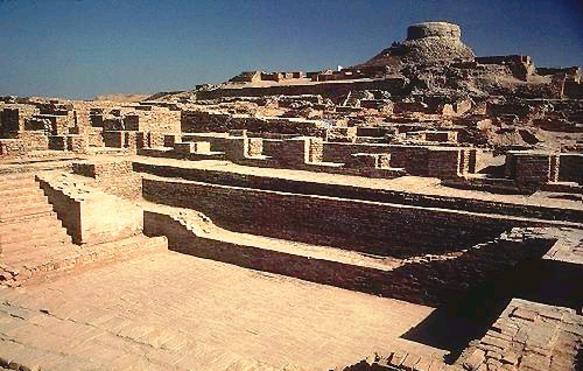
Great Bath, Mohenjodao
- The Great bath at Mohenjodaro is a unique example.
- Mohenjodaro is noted for its large number of wells.
- In the city of Mohenjodaro, there may have been more than 700 wells.
- Most houses or house blocks had at least one private well.
- Many neighbourhoods had public wells along the main street.
- Harappa had much fewer wells but a depression in the centre of the city may represent a tank or reservoir that served the city’s inhabitants.
- There are a few wells at Dholavira, which is noted more for its impressive water reservoirs lined with stone.
- Dholavira had water storing tanks and step wells.

A water well in Lothal
- Dholavira had water storing tanks and step wells.
- The Harappans made elaborate arrangements for water for drinking and bathing.
Other water management features:
- In Allahdino (Near Karachi), the wells had very small diameter to enable the ground water to rise higher due to hydraulic pressure.
- It may have been used to irrigate the nearby fields.
- The city of Dholavira had an impressive and unique water harvesting and management system.
- Dholavira’s system of water management was architectural marvel which was crucial in an area, which is prone to frequent droughts.
- Rain water in the catchment areas of the two seasonal streams – Manhar and Mansar – was dammed and diverted to the large reservoirs within the city walls.
- Several large, deep water cisterns and reservoirs have been found which preserved precious stores of rain water.
- Apparently, there were 16 water reservoirs within the city walls, covering as much as 36 percent of the walled area.
- Brick masonry walls protected them, although reservoirs were also made by cutting into the bedrock.
-
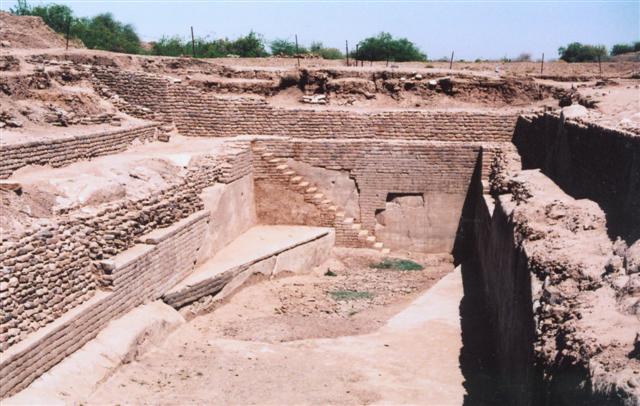
Dholavira Water Reservoir
- Dockyard of Lothal is the most distinctive feature of the site.
- It is roughly trapezoidal basin, enclosed by walls of burnt bricks.
- The dockyard had provisions for maintaining a regular level of water by means of a sluice gate and a spill channel.
-

Lothal Dockyard
-

